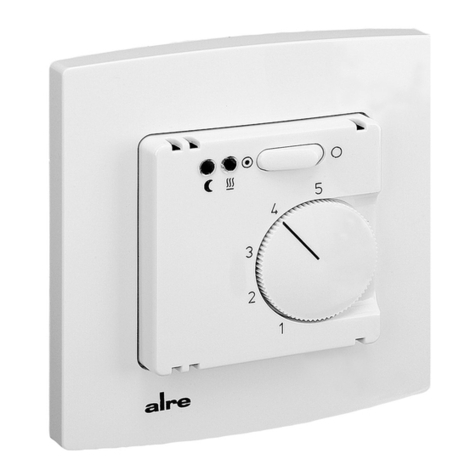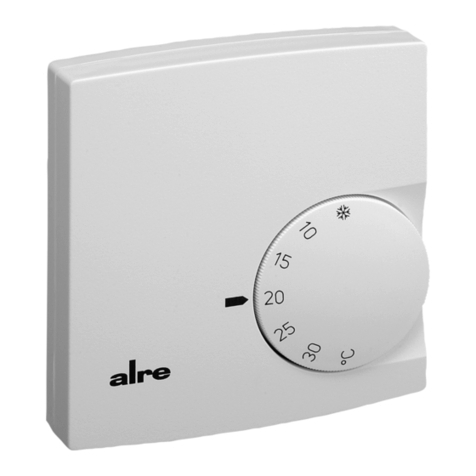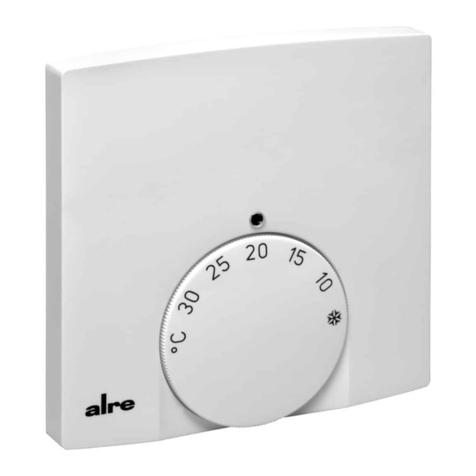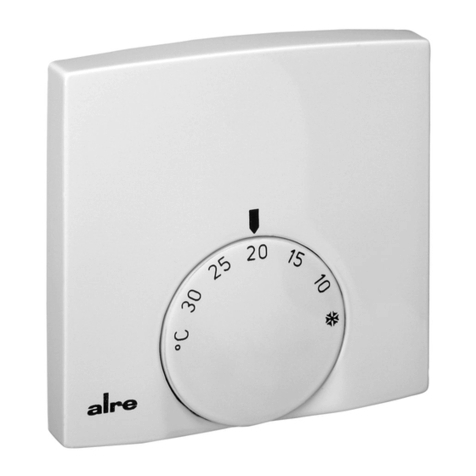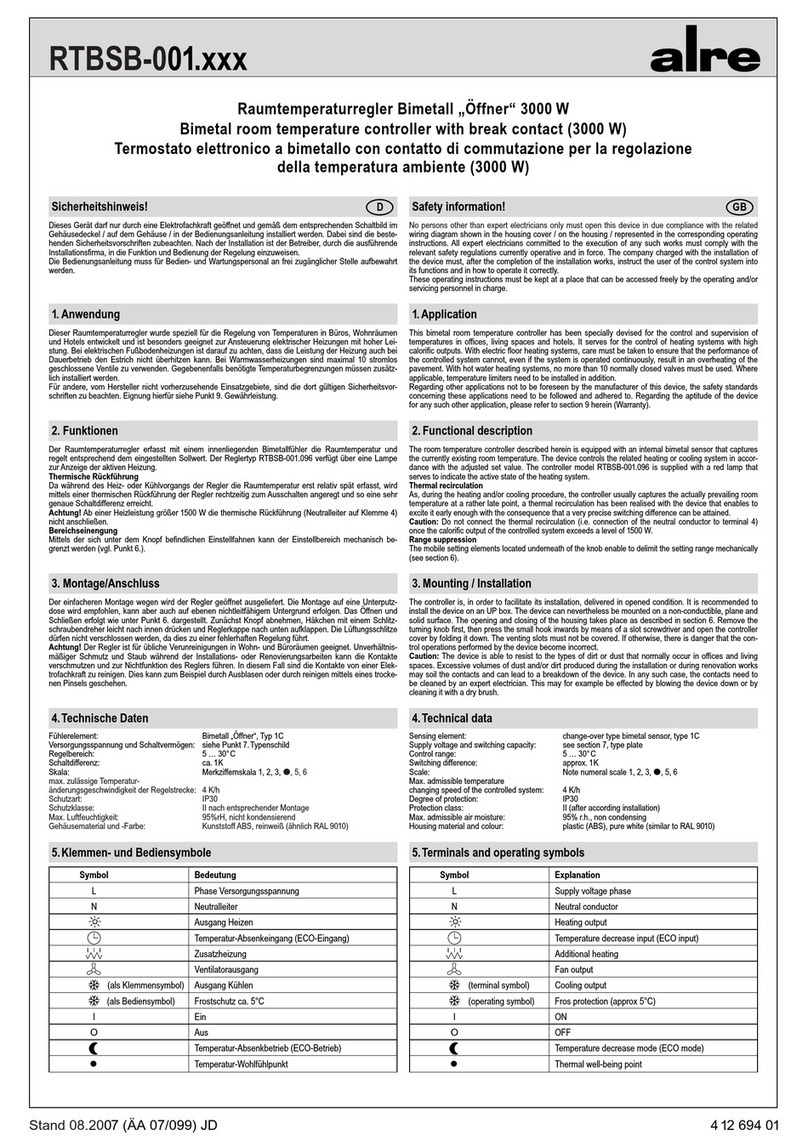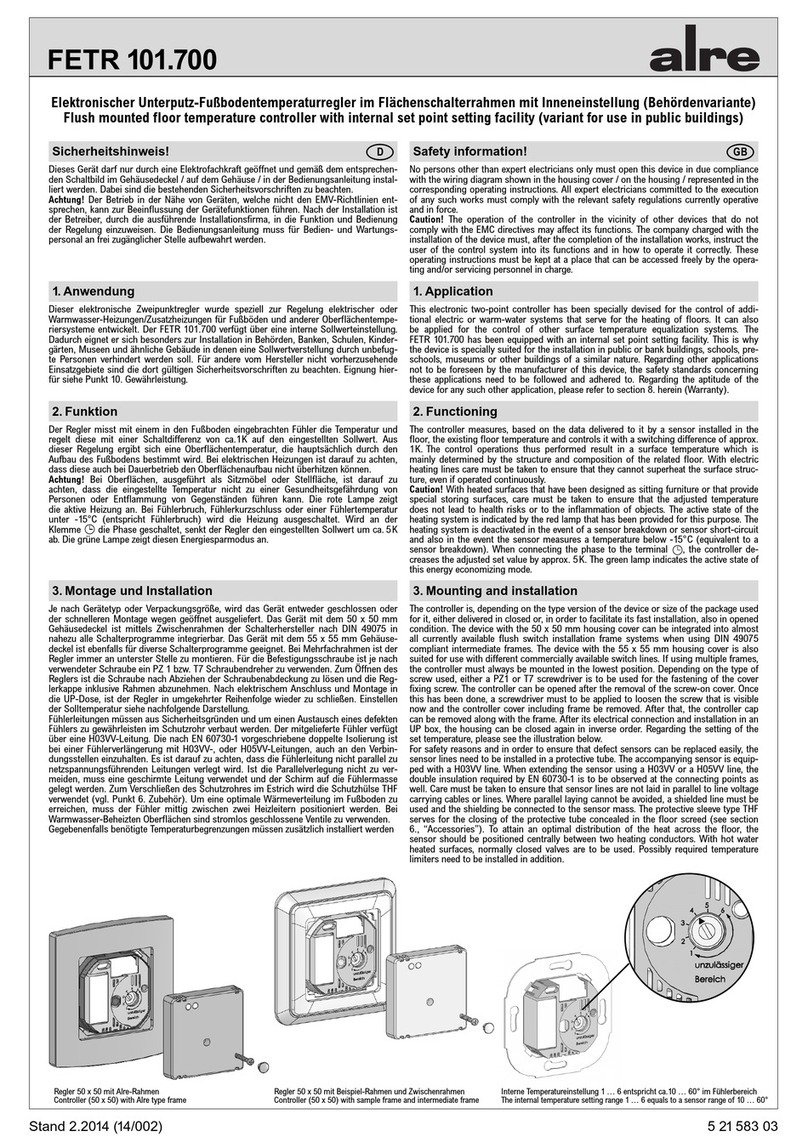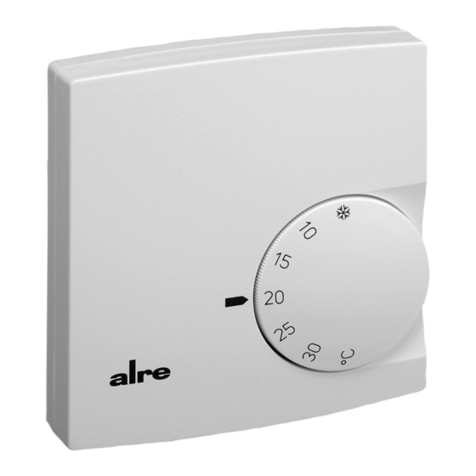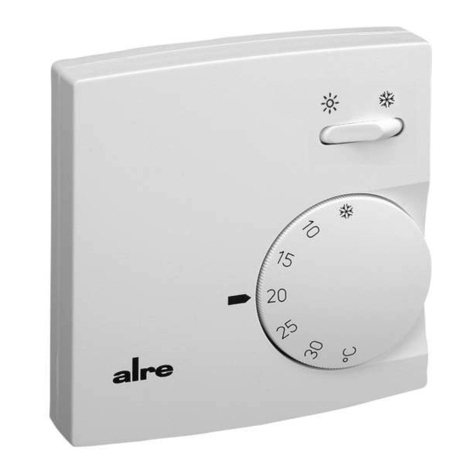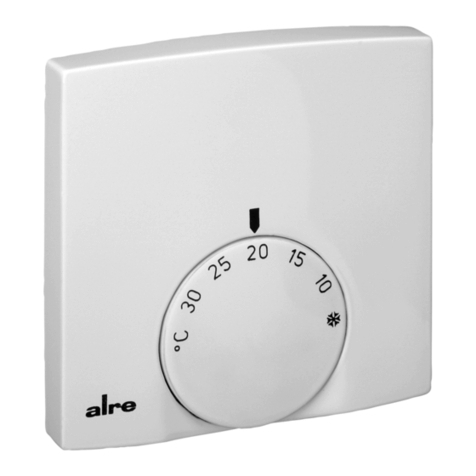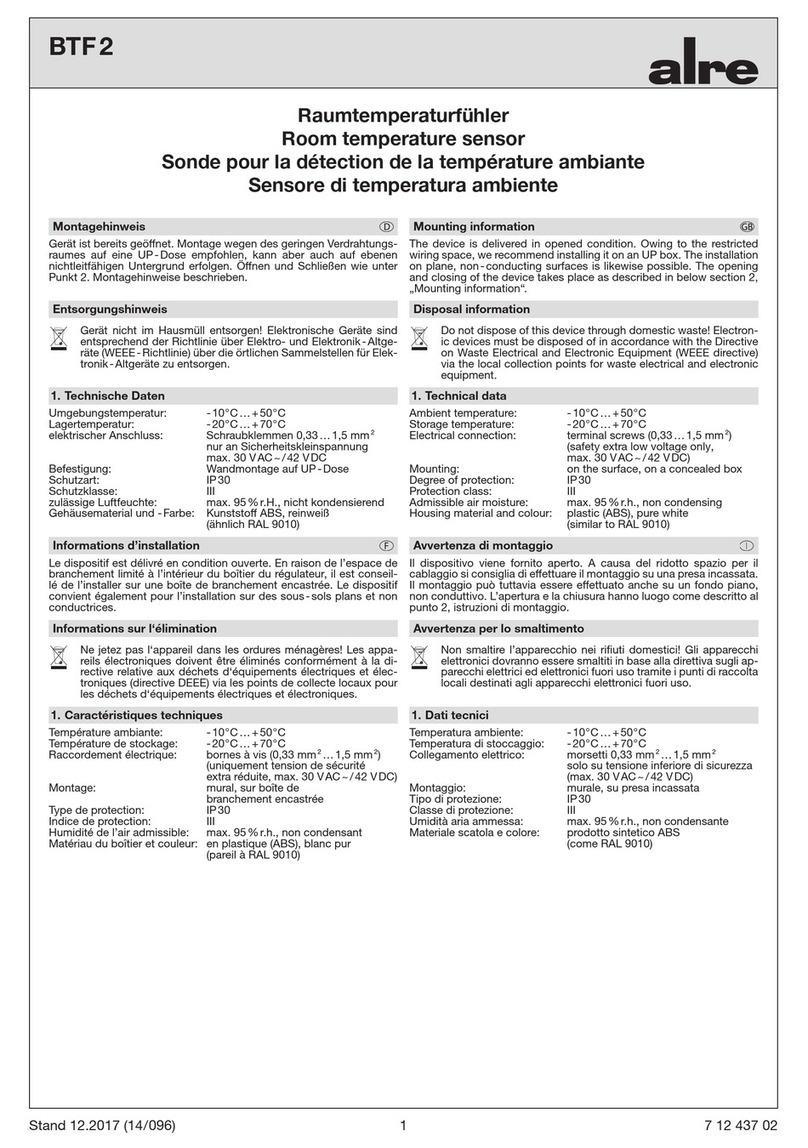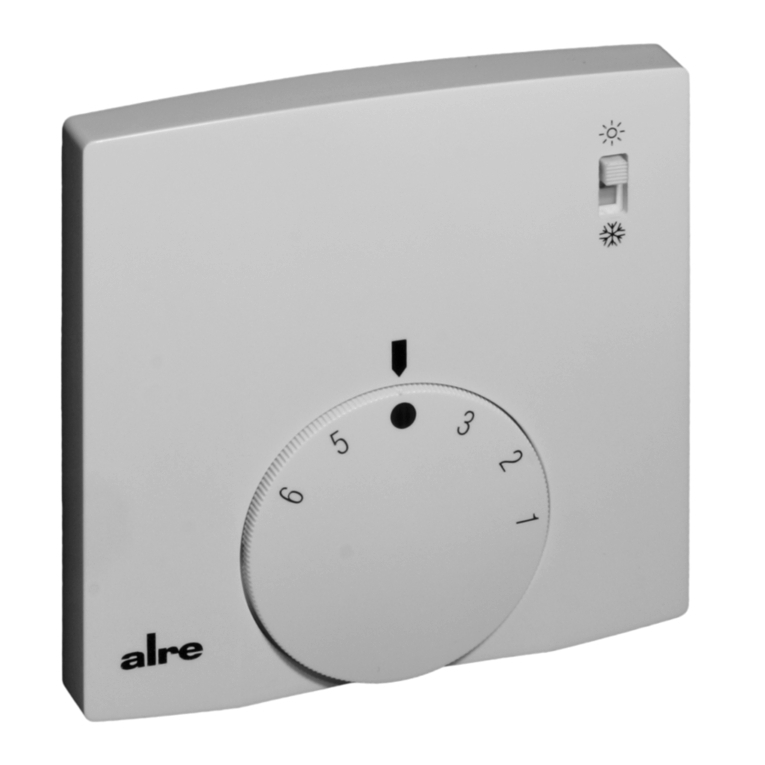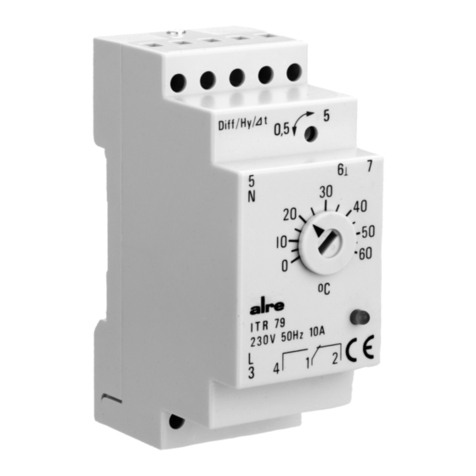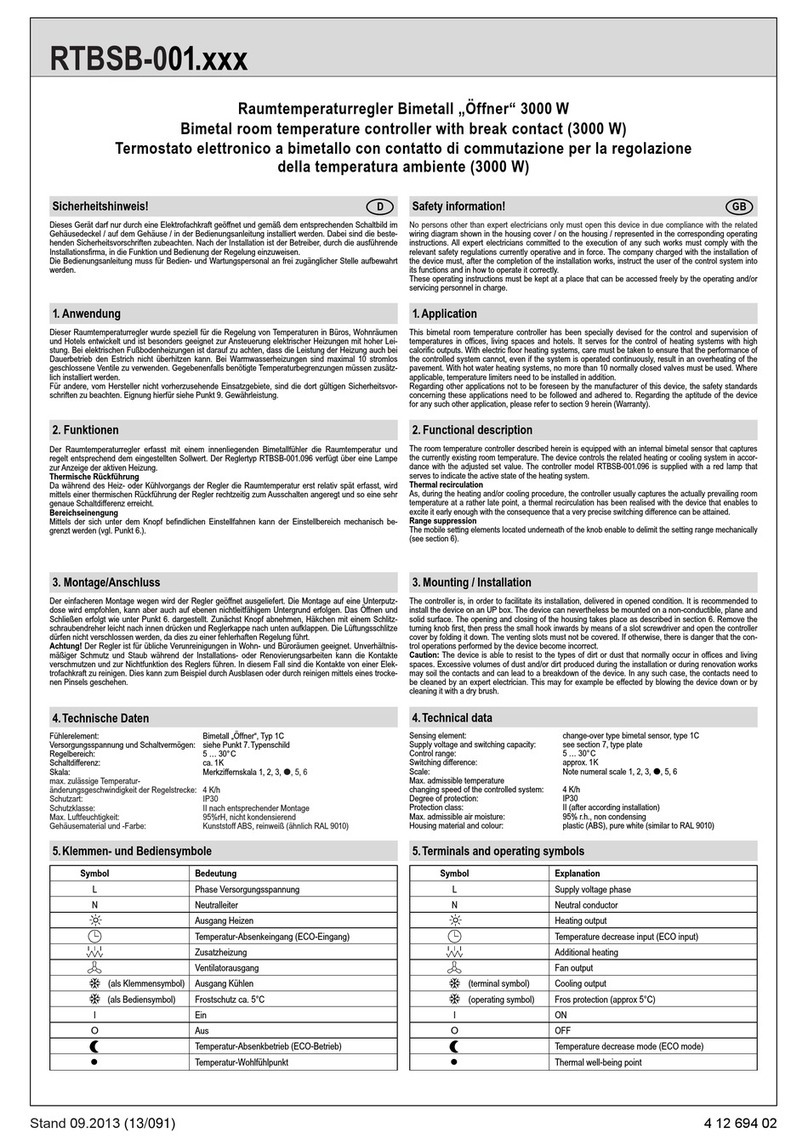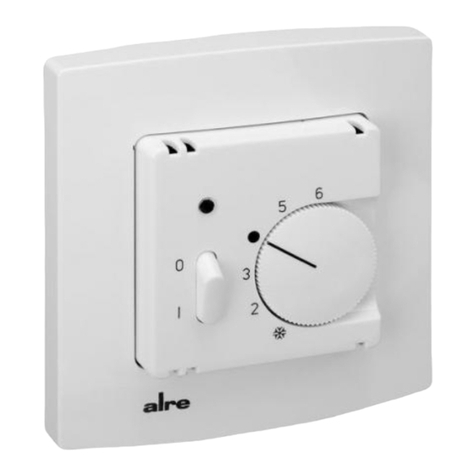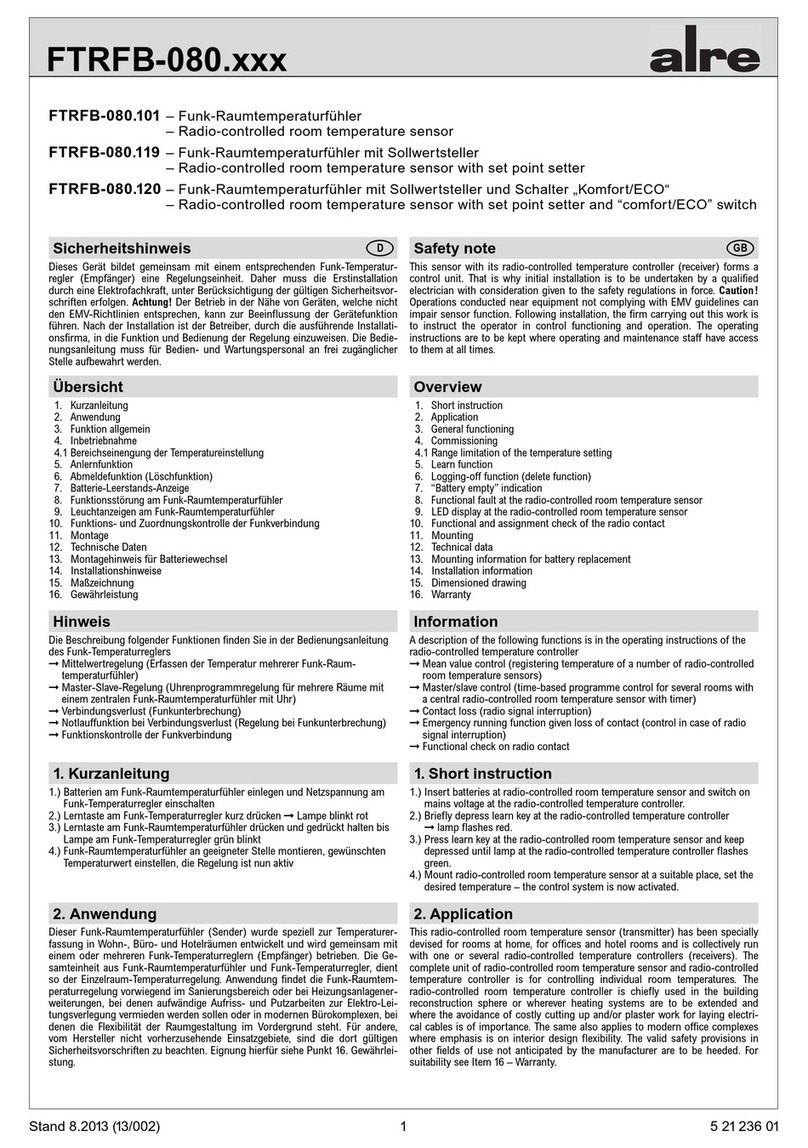
1Stand 12.2017 (14/096) 4 12 672 07
RTBSB - 201.xxx
Raumtemperaturregler Bimetall / Bimetal room temperature controller
Régulateur bimetallique pour le réglage de la temperature ambiante
Sicherheitshinweis!
Dieses Gerät darf nur durch eine Elektrofachkraft geönet und gemäß dem entsprechenden
Schaltbild im Gehäusedeckel/auf dem Gehäuse/in der Bedienungsanleitung installiert wer-
den. Dabei sind die bestehenden Sicherheitsvorschriften zu beachten. Nach der Installation
ist der Betreiber, durch die ausführende Installationsfirma, in die Funktion und Bedienung der
Regelung einzuweisen. Die Bedienungsanleitung muss für Bedien- und Wartungspersonal an
frei zugänglicher Stelle aufbewahrt werden.
Safety information!
This bimetal room temperature controller is only to be opened by a qualified electrician and
installed in keeping with the wiring diagram on the housing cover/ on the cover /and in the
operating instructions. In so doing, the safety regulations are to be noted. Following installation,
the company concerned is to instruct the operator in the function and operation of the control
system. The operating instructions are to be kept at a place that is easily accessible for both
operating and maintenance sta.
1. Anwendung
Dieser Raumtemperaturregler wurde speziell für die Regelung oder Überwachung von Tempe-
raturen in Büros, Wohnräumen und Hotels entwickelt. Elektrische Fußbodenheizungen müssen
über einen zusätzlichen Leistungsschutz angesteuert werden. Hierbei ist darauf zu achten,
dass die Leistung der Heizung auch bei Dauerbetrieb den Estrich nicht überhitzen kann. Bei
Warmwasserheizungen sind maximal 10, bei Kühlung maximal 5 stromlos geschlossene Ven-
tile zu verwenden. Gegebenenfalls benötigte Temperaturbegrenzungen müssen zusätzlich ins-
talliert werden. Für andere, vom Hersteller nicht vorherzusehende Einsatzgebiete, sind die dort
gültigen Sicherheitsvorschriften zu beachten. Eignung hierfür siehe Punkt8. Gewährleistung.
2. Funktionen
Der Raumtemperaturregler erfasst mit einem innenliegenden Bimetallfühler die Raumtempe-
ratur und regelt entsprechend dem eingestellten Sollwert. Die Reglertypen RTBSB- 201.023
und RTBSB-201.062 verfügen über einen „EIN/AUS“-Schalter, der Typ RTBSB - 201.062
zusätzlich über eine rote Lampe „Heizen“. Der RTBSB - 201.075 verfügt über einen Schalter
„Absenken/Tag / Uhrenbetrieb“ und eine grüne Lampe „Absenkbetrieb“. Der RTBSB - 201.065
wurde speziell für 2- Rohr -Leitungssysteme entwickelt und verfügt für den gemeinsamen
Heiz-Kühlausgang über einen Heiz-Kühl-Umschalter. Durch eine thermische Rückführung
wird eine sehr genaue Schaltdierenz erreicht. Bereichseinengung siehe Bild2. Bei Beschalten
der Klemme mit 230 V~ wird auf eine um ca. 3K geringere Temperatur geregelt (Nachtab-
senkung).
4. Technische Daten
Fühlerelement/Kontakt: Bimetall, Öner oder Wechsler Typ 1 C
Versorgungsspannung und
Schaltvermögen: 250 V~, 2(1)A
Regelbereich: 5°C…30°C
Schaltdierenz: ca. 0,5K
Skala: °C Skala bzw. Skala *…6
(entspricht 5°C … 30°C)
max. zulässige Temperatur-
änderungsgeschwindigkeit
der Regelstrecke: 4K/h
Schutzart: IP30 nach entsprechender Montage
Schutzklasse: II nach entsprechender Montage
Max. Luftfeuchtigkeit: 95%rH, nicht kondensierend
Bemessungsstoßspannung: 4000 V
Verschmutzungsgrad: 2
Energieezienzklasse: I (Beitrag zur jahreszeitbedingten
Raumheizungs-Energieezienz 1%)
Symbol Erklärung
L Phase Versorgungs- und Schaltspannung
N Neutralleiter Versorgung und Verbraucher
Ausgang Heizen
Ausgang Kühlen oder Kühlbetrieb oder Frostschutz (5°C)
Temperatur-Absenkbetrieb (ECO-Betrieb)
Temperatur-Absenkeingang (ECO-Eingang)
I Ein
0 Aus
5. Verwendete Symbole
1. Application
This bimetal room temperature controller has been specially devised for the control and super-
vision of temperatures in oces, living spaces and hotels. Electric floor heating systems need
to be controlled by an additional power contactor. Care must be taken thereby to ensure that
the performance of the controlled system cannot, even if the system is operated continuously,
result in an overheating of the pavement. With hot water heating systems, no more than 10
normally closed valves must be used and no more than 5 with water cooling systems. Where
applicable, temperature limiters need to be installed in addition. Notice is to be taken of those
safety regulations applying to other fields of use not anticipated by the manufacturer. For suit-
ability in this respect see Item8 Warranty.
2. Functional description
The room temperature controller described herein has been equipped with an internal bi-
metal sensor that captures the currently existing room temperature. The device controls the
related heating or cooling system in accordance with the adjusted set value. The controller
models RTBSB-201.023 and RTBSB-201.062 have been equipped with an ON/OFF switch,
while the controller model RTBSB- 201.062 disposes of an additional red „heating” lamp.
The RTBSB-201.075 has been provided with a „temperature decrease mode/ daytime op-
eration/ clock -controlled operation” selector switch and with a green „temperature decrease
mode” lamp. The RTBSB-201.065 has been specially devised for the control of 2-pipe sys-
tems and equipped with a joint heating/cooling output, the control of which is eected by a
changeover switch. The thermal recirculation realised with the devices of this series enables
to attain a highly precise switching dierence. Regarding the suppression of the setting range,
please see picture2. The room temperature is decreased by approx. 3K when connecting the
230 V~ power supply to the terminal (night temperature decrease).
3. Mounting / Installation
The controller is delivered in opened condition. As there is only little space available for its wir-
ing, it is recommended to install the device on an UP box. The controller can nevertheless be
mounted on a non-conductible surface. The opening and closing of the housing takes place as
described in picture1. The venting slots that point to the wall must not be covered. If otherwise,
there is danger that the control operations performed by the device become incorrect.
Caution: Always make sure to pull o the knob only prior to removing the housing cover! The
adjusting knob must neither be put on, nor be pulled o without having put on the housing
cover beforehand!
Caution: The device is able to resist to the types of dirt or dust that normally occur in oces
and living spaces. Excessive volumes of dust and/or dirt produced during the installation or
during renovation works may soil the contacts and can lead to a breakdown of the device.
4. Technical data
Sensing element/contact: bimetal sensor, type 1 C/open or break contact
Supply voltage and switching
capacity: 250 V~, 2(1) A
Control range: 5°C … 30°C
Switching dierence: approx. 0.5K
Imprinting: °C scale or scale *… 6
(equivalent to 5°C…30°C)
Max. admissible temperature
changing speed of the
controlled system: 4K/h
Degree of protection: IP30 (after according installation)
Protection class: II (after according installation)
Max. admissible air moisture: 95%rh, non- condensing
Rated impulse voltage: 4000 V
Degree of pollution: 2
Energy eciency class: I (contribution to seasonal space heating
energy eciency 1%)
Symbol Explanation
L Supply and switching voltage (phase)
N Supply and consumers (neutral conductor)
Heating output
Cooling or cooling mode or frost protection (5°C) mode output
Temperature decrease mode (ECO mode)
Temperature decrease mode (ECO input)
I ON
0 OFF
5. Explanation of symbols
Entsorgungshinweis
Gerät nicht im Hausmüll entsorgen! Elektronische Geräte sind entsprechend der Richt-
linie über Elektro- und Elektronik- Altgeräte (WEEE-Richtlinie) über die örtlichen Sam-
melstellen für Elektronik- Altgeräte zu entsorgen.
3. Montage / Anschluss
Auslieferungszustand oen. Montage wegen des geringen Verdrahtungsraumes auf eine
UP-Dose empfohlen, kann aber auch auf ebenen nichtleitfähigen Untergrund erfolgen. Önen
und Schließen wie in Bild1 beschrieben. Die zur Wand zeigenden, verdeckten Lüftungsschlitze
dürfen nicht verschlossen werden, da dies zu einer fehlerhaften Regelung führt.
Achtung! Den Einstellknopf immer erst vor dem Abnehmen des Gehäusedeckels abziehen!
Der Einstellknopf darf nicht ohne vorheriges Aufsetzen des Gehäusedeckels aufgesteckt und
wieder abgezogen werden!
Achtung! Der Regler ist für übliche Verunreinigungen in Wohn- und Büroräumen geeignet. Un-
verhältnismäßiger Schmutz und Staub während der Installations- oder Renovierungsarbeiten
kann die Kontakte verschmutzen und zur Nichtfunktion des Reglers führen.
Disposal information
Do not dispose of this device through domestic waste! Electronic devices must be
disposed of in accordance with the Directive on Waste Electrical and Electronic Equip-
ment (WEEE directive) via the local collection points for waste electrical and electronic
equipment.
1. Knopf abnehmen /
Remove the knob / Enlever le bouton
2. Schraube entfernen /
Unscrew the screw / Dévisser la vis
3. Drücken /
Press / Presser
4. Ziehen /
Pull / Tirer
Einstellfahne für minimalen
Temperaturwert
Pin for the setting of the
minimum temperature value
Broche pour l’ajustage de la
valeur de température minimale
Einstellfahne für maximalen
Temperaturwert
Pin for the setting of the
maximum temperature value
Broche pour l’ajustage de la
valeur de température maximale
Bild 1 / Picture 1 / Illustration 1 Bild 2 / Picture 2 / Illustration 2
